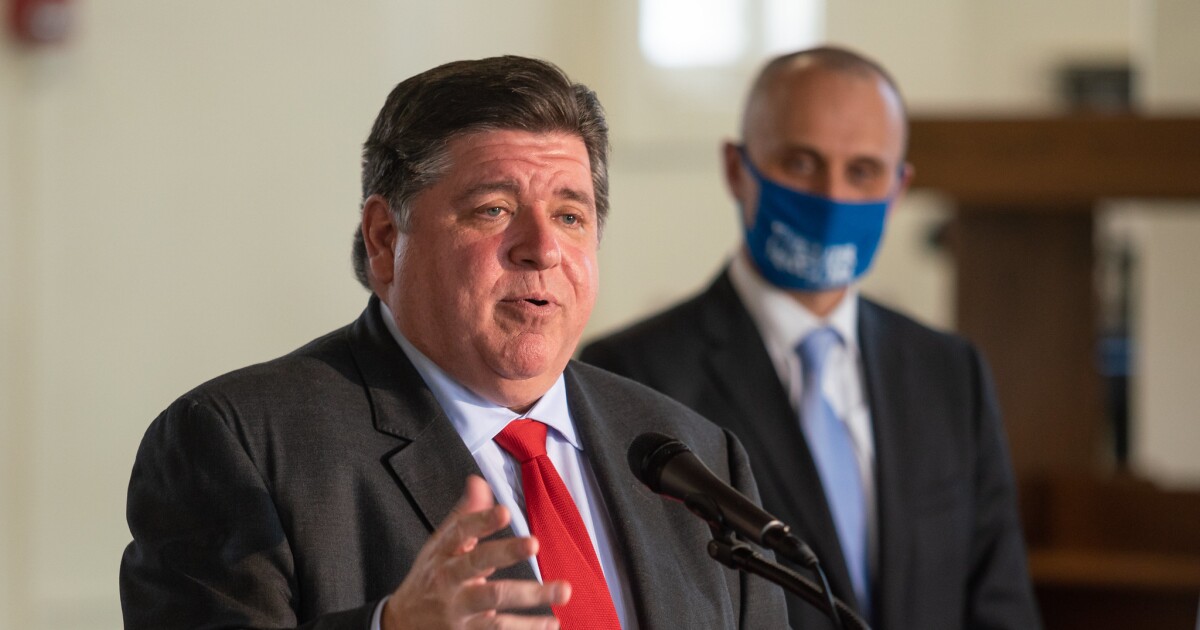With revenues strong, Illinois governor targets rainy day fund and debt
5 min read
Illinois would double the size of its $1 billion rainy day fund and further pay down a federal unemployment insurance loan and other debt under proposals laid out by Gov. J.B. Pritzker to tap healthier-than-expected revenues.
The latest fiscal picture came Monday in the Governor’s Office of Management and Budget Annual Economic and Fiscal Policy Report, which provides a view of the current fiscal year, projections for the next five years, and the governor’s policy objectives.
The state raised its revenue estimates for the current fiscal year that runs through June 30 by $3.69 billion due to the healthier pace of income and sales tax collections so far as well as other one-time revenue streams.
In a statement, Pritzker said his proposed use of the surplus would “continue Illinois’ strong path forward, and put the state in the best possible fiscal position to prepare for the economic uncertainty that lies ahead.”
The current fiscal overview marks a sharp contrast from the 2019 report early in Pritzker’s first term when the state was drowning in a sea of red ink.
Long-term, pensions still weigh heavily on the state’s balance sheet, but paying off a massive bill backlog along with some other debts and healthier tax collections last year have put the state in a stronger near-term position and chipped away at out-year deficits. Federal COVID-19 relief also continues to prop up the budget.
Pritzker’s proposals tapping some of the surplus will require General Assembly approval. Senate President Don Harmon, D-Chicago’s spokesman John Patterson said the proposals were under review.
The once-barren budget stabilization fund that received an infusion of $1 billion over the last year would get another injection of $1.3 billion, bringing the fund to about 5% of state sourced general fund revenues.
Most states set a goal for their rainy day funds between 5% and 15%, according to the National Conference of State Legislatures.
Illinois Comptroller Susana Mendoza, who backs proposed legislation in HB4118 that would establish additional annual funding requirements for the budget and pension stabilization funds, endorsed the proposal.
“This responsible budgeting will send exactly the right message to the bond rating agencies that Illinois remains a good investment and is serious about restoring our fiscal health,” Mendoza said.
Both Mendoza and Pritzker were reelected by comfortable margins last week.
The state has brought its tab of unpaid bills down to $1.5 billion at the close of fiscal 2022 in June from a peak of more than $16 billion in 2017 and Mendoza reports that bills are paid on a routine cycle now. Pritzker’s proposals would further chip away at the tab reducing it to $1.2 billion by fiscal year end.
Pritzker wants a portion of the surplus to further pay down the remaining $1.345 billion outstanding from the state’s $4.5 billion federal loan used to help pay unemployment claims that skyrocketed early in the COVID-19 pandemic. The state tapped $2.7 billion of its $8 billion in American Rescue Plan Act relief previously to pay down a portion and in September announced a trust fund surplus would further reduce it.
Negotiations have been ongoing between the state, business groups, and labor over how to fully close the gap with benefit cuts, bonding, and employer tax hikes on the table.
The state would pay off a portion of the outstanding $561 million balance on $1.5 billion of tobacco bonds through a cash defeasance.
The state borrowed in 2010 through its special entity known as the Railsplitter Tobacco Settlement Authority securitizing its share of the 1998 settlement with tobacco companies to pay down state bills that had mounted during the Great Recession.
The proposal doesn’t rely on the surplus but on funds received by Attorney General Kwame Raoul’s office that settled claims over payment amounts with the tobacco companies. The freed-up stream of tobacco settlement payments would go to support Medicaid costs.
The state is specifically targeting one-time measures for the surplus so as not to structurally strain the budget especially given worries that a recession looms.
“While parts of the economy are holding on to recovery gains, others are raising serious concerns. Inflation has taken hold as a main economic concern,” said the state forecast report which draws economic data from IHS Markit’s baseline October forecast.
The state’s use of past surplus revenues such as rebuilding the rainy day fund, paying down overdue bills and an employee health insurance tab and making $500 million in supplemental contributions to help curtail growth in the state’s $139.9 billion of unfunded liabilities drew a round of rating upgrades that lifted the state to the Baa1/BBB-plus level. The upgrades were featured prominently in Pritzker’s successful reelection campaign.
The fiscal 2023 budget originally anticipated an ending balance of $132 million but so far this year income and sales tax collections are up $1.47 billion. A larger than forecast fiscal 2022 balance in the income tax refund account also led to a one-time transfer this year of $1.28 billion.
Overall, the state is raising the general fund revenue forecast from state funds by $3.69 billion to $45.26 billion. Federal dollars and one-time use of ARPA monies as a reimbursement for government services totaling $763 million boosts resources to $50.1 billion.
Increased expenses will eat away at $832 million of surplus, including $250 million to pay down a technology revolving fund. Pritzker’s proposal to direct $1.3 billion to the rainy day fund would leave the state with a revised end-of-year surplus of $1.69 billion.
The state now anticipates a $357 million surplus for fiscal 2023 and then deficits return of $384 million, $625 million, $567 million, and $708 million in 2024, 2025, 2026, and 2027. Scheduled rainy day fund deposits of around $80 million annually would add to the gaps.
Pritzker came into office in 2019 with a 2023 gap of $2.9 billion forecast.
Any further fiscal progress on fiscal metrics would help the state’s pursuit of further upgrades as it remains the weakest rated state that pays the highest yield penalty, which makes it more susceptible to market turmoil.
Illinois’ 10-year is trading at a 171 basis point spread to the Municipal Market Data’s AAA benchmark and a 185 bp spread on its long, 25-year bond. That’s far from the 63/66 bp spread Illinois traded at when the year began the year before rates began to rise and funds began pulling their investments.
“I think Illinois is an improving credit, a gradually improving credit, but they have headwinds,” said Vikram Rai, head of municipal strategy at Citi. “I never thought Illinois should have been on the verge of a speculative grade so the upgrades are undoing the damage” done by earlier downgrades.
While the current tax picture remains bright given the state’s conservative estimates used to craft the fiscal 2023 budget, a potential recession weighs as it might not show up in tax collection hits until late next year or early 2024. Pension pressures also could mount given weak returns this year, Rai said.
Given the headwinds and narrow spreads across the curve, Rai believes short and intermediate maturities offer the best “value” while avoiding while avoiding duration risks.
The forecast report comes ahead of the start of the legislature’s veto session. It wasn’t immediately clear if any action would be sought on the proposals during the veto session or if they would wait for the 2023 spring session that begins early next year. Pritzker is a Democrat and the party retained supermajorities in the House and Senate.







